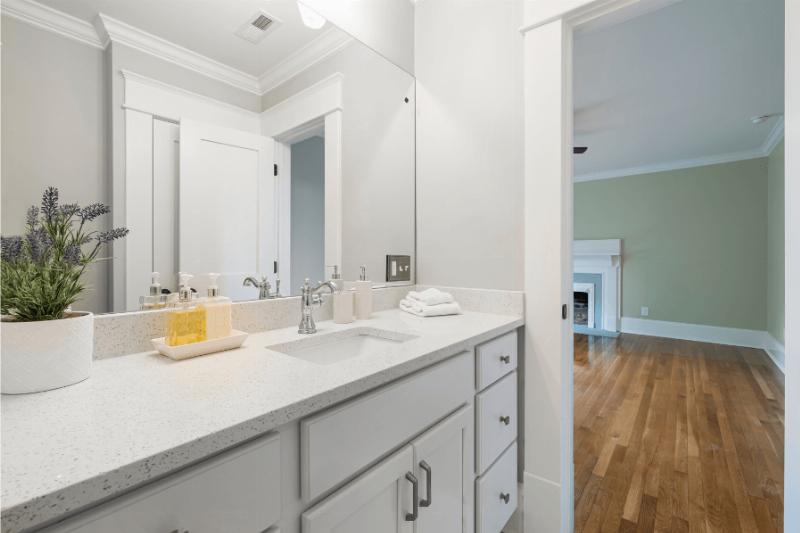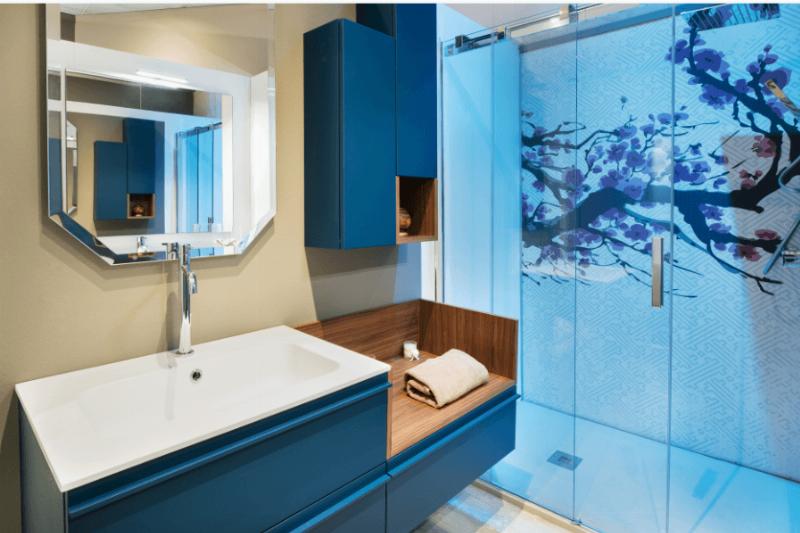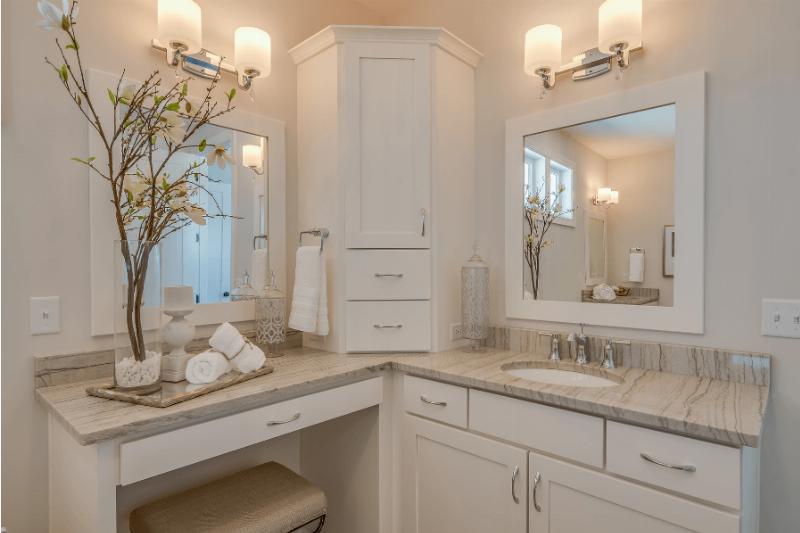Key Takeaways
Painting your bathroom vanity is a feasible DIY project, even for beginners.
Proper preparation, including surface cleaning, sanding, priming, and masking, is essential for achieving professional-looking results.
Choose paint colors and finishes that complement your bathroom decor and lighting conditions.
DIY is achievable. However, you can also seek assistance from professionals like Smart Remodeling LLC to ensure a high-quality finish and streamline the process.
Success lies in attention to detail, which includes proper surface preparation, application techniques, and patience throughout the process.
_____________________________________________________________
If you’re thinking about painting your bathroom cabinets but need help figuring out where to start, this article is for you.
Painting a bathroom vanity may seem daunting, but with the right approach and a bit of determination, it’s a DIY project that can completely transform the space’s look and feel.
Whether you’re seeking to refresh an old bathroom vanity or if you’ve got a new one but don’t like the color. Fear not – it’s entirely achievable with the right guidance.
In this comprehensive guide, we’ll walk you through the process, from prepping and priming to painting and reinstallation. By following these steps, you’ll be well on your way to achieving a refreshed bathroom vanity in less time than you expect.
Tools and Materials Needed
Tools
Screwdriver or drill
Sandpaper (220-grit)
Paintbrushes
Paint roller and tray
Painter’s tape
Scrubbing pad or sponge
Tack cloth or damp rag
Putty knife (for filling holes with putty)
Vacuum cleaner (for cleaning up dust)
Heat gun (if dealing with thermofoil or melamine surfaces)
Materials
Trisodium phosphate (TSP) cleaner
Wood putty (if filling holes)
Primer Paint
Painter’s gloves (optional)
Drop cloths or plastic sheeting (to protect surrounding areas from paint splatter)
Paint thinner or mineral spirits (for cleanup if using oil-based paints)
Hardware (optional)
Step-by-Step Guide to Painting a Bathroom Vanity

Here is a step-by-step guide to painting your bathroom vanity and getting professional-looking results. Gather your tools and materials, and let’s begin!
|
Project Overview
|
|
|
Work Time |
1 – 2 days |
|
Total Time |
3-5 hours |
|
Skill Level |
Beginner |
|
Est. Cost |
$100-$200 |
1. Assess the Condition
First thing first. Before you begin painting, examine your wood bathroom vanity to determine its condition. If your vanity looks old-fashioned but still strong and sturdy, painting it can make it look fresh rather than buying a new one.
2. Remove Hardware and Prep the Surface
Now, remove all the handles, knobs, drawers, and doors from your vanity. If you’re going to keep the top part of the vanity, take it off too.
This will save time later when you’re covering it up. If you’re changing the handles or knobs and they don’t fit the old holes, fill those holes with putty and smooth them out by sanding.
3. Clean the Surface
Next, clean all the parts of the vanity that you will paint with trisodium phosphate (TSP). You can use a scrubbing pad or sponge to do this. Follow the TSP instructions and rinse the surfaces thoroughly with fresh water twice before sanding.
4. Sand the Surface
Use 220-grit sandpaper to sand wood surfaces protected by a clear finish. Sanding removes gloss and helps the new paint adhere properly. If you are dealing with thermofoil or melamine surfaces, sand lightly until they appear dull. This makes sure the surface is ready for painting.
5. Prime the Surface
Now, it’s time to apply a coat of primer using a brush and roller. If your vanity has a glossy surface or the final paint is glossy, a primer is important.
For surfaces like thermofoil or melamine, using a shellac-based primer for better adhesion is a good idea.
After applying the primer, let it dry completely. Then, use sandpaper to smooth out rough spots and wipe it clean before painting.
6. Mask Off Surroundings
Use painter’s tape to mask off the vanity top, surrounding walls, furniture, and the inside face of the cabinet frame. Do this carefully and neatly to save time later when you’re painting.
7. Apply Paint
Now comes the fun part—painting! First, pick the color and type of paint you want. We will use Valspar Iron Frost (4007-2B) paint. Use a brush or roller to apply a full coat of paint, covering the entire surface. Let it dry completely before adding another layer. Apply two more coats for even coverage and a smooth finish.
8. Remove the Tape and let it dry
After the final coat of paint has dried, carefully remove the painter’s tape. Let the painted vanity dry overnight before reassembling.
9. Reassemble the Vanity
Now, it’s time to put everything back together. If necessary, drill new holes for hardware. Then, put the drawers and doors back in place, ensuring they open and close smoothly. If you have got new hardware, like new handles or knobs, put them on now.
10. Final Touches
Once the vanity is reassembled, add any final touches to make it look perfect. This could mean putting in a new faucet or any other accessories you like.
By following these steps and using tools and materials readily available from hardware stores, you can make your bathroom vanity look brand new again.
Beforehand Preparation for the Project

Before diving into painting your bathroom vanity, it’s crucial to ensure that you’re properly prepared for the project ahead.
Choosing the Right Paint
The choice of paint is crucial for a bathroom vanity project due to the unique conditions in a bathroom, including high humidity and varying temperatures. Here’s what to consider:
Oil-based vs Water-based Paint: Oil-based paints are durable and resistant to moisture, making them a traditional choice for bathrooms. However, they have a longer drying time and a more pungent odor. Water-based paints, meanwhile, are easier to work with and clean up but may require a topcoat to achieve the same durability.
Choosing the Ideal Vanity Color
Choosing the perfect color for your vanity can significantly impact the overall look of your bathroom. Here are some tips to help you select the ideal color:
Consider the Bathroom Decor: Take into account the existing color scheme and decor of your bathroom. Choose a vanity color that complements the other elements in the room, such as the wall color, tiles, and fixtures.
Think About the Mood: Different colors evoke different moods and feelings. For example, cool tones like blue and green can create a calming atmosphere, while warmer tones like beige and brown can add warmth and coziness to the space.
Evaluate Lighting Conditions: Lighting significantly affects how colors appear in a space. Take note of the natural and artificial lighting in your bathroom. If the room receives ample natural light, you may have more flexibility with darker colors.
In contrast, if the lighting is limited, lighter shades can help brighten the space and make it feel larger.
Test Samples: Before committing to a color, it’s a good idea to test paint samples on a small vanity area or a spare piece of wood.
This allows you to see how the color looks in the actual lighting conditions of your bathroom and ensures that you’re happy with the choice before proceeding.
Determining the Finish
Decide on the level of shine you want for your bathroom vanity. A semi-gloss finish is often a good choice because it handles moisture well, which is common in bathrooms. Satin is another durable and easy-to-clean option, perfect for this part of your house.
Take Help from Smart Remodeling LLC
If you’re looking to spruce up your bathroom by painting the vanity, Smart Remodeling LLC in Houston can be a valuable resource. They specialize in home and commercial remodeling and offer services for smaller projects like installing and painting bathroom vanities. With their expertise, they can ensure that your vanity receives a professional paint job.
By getting help from Smart Remodeling LLC, you can make your bathroom look nicer without too much trouble.
Conclusion
Painting a bathroom vanity can refresh your bathroom’s appearance without a full renovation. By carefully selecting the right paint, preparing the surface, and applying the paint correctly, you can achieve a durable and professional-looking finish. Remember, the key to a successful project is attention to detail and patience.






